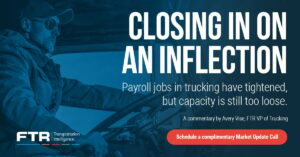Basic liability insurance costs for truckers have stabilized, but there continues to be upward pressure on pricing for excess coverage due to nuclear verdicts in the U.S., which are increasingly common in Canada as well.
Speakers from the trucking insurance industry gave an update during the Truckload Carriers Association’s annual Bridging Border Barriers event in Mississauga, Ont., Nov. 8. And just like the truckers in the room, the insurance representatives said they too are dealing with rising costs, which have been driving insurance premiums higher.

“Underwriters are moving away from insuring excess layers, which starts to drive the price up,” said Matthew Yeshin, managing director of Marsh Canada, referring to policies that go beyond basic liability coverage.
Excess liability insurance covers those larger claims such as the nuclear verdicts. Insurers offering such coverage are raising premiums as a result, or exiting that business altogether.
“Those that go into the U.S. and carry excess limits, that’s where the challenge lies,” agreed Linda Desouza, vice-president – auto and transportation, Zurich Canada. “[Insurance] capacity is very limited and as you start assessing U.S. exposure, the number of [insurance] carriers willing to provide excess [coverage] in that space starts to shrink, which drives prices up. That’s where I see the biggest challenges.”
Insurance and technology
In addition to nuclear verdicts, insurers are seeing their costs rise because trucks are more tech-laden and expensive to repair, and climate change has increased the risks of flood and storm damage. Fleets should be using technology to mitigate the risk of claims and even consider routing trucks away from areas where nuclear verdicts and severe weather are more likely to be encountered, panelists said.
Another area in which insurance costs are rising is cyber liability coverage. Costs for such coverage has climbed as much as 600% in the past year, Yeshin said, due to the rising frequency and claims costs related to cyber losses.
“We are seeing an increase in the frequency and severity of claims from a cyber liability perspective,” he said. “It’s tainting the insurance industry but it’s hard to have a solution when there’s almost an inevitability of losses, and that’s across all industries. Every industry is getting hacked but the transportation space is particularly challenged because there are so many interactions with so many outside bodies. It really does open up your network.”
All this has been compounded by the supply chain challenges facing the industry, added Luis Costa, account manager – programs, with claimspro. An inability to secure parts and labor needed to repair vehicles has also driven up claims costs. And let’s not forget the rising costs associated with environmental remediation following spills – those too continue to rise.

What can fleets do to control insurance costs?
Fleets can mitigate rising insurance costs by running dedicated routes and having preferred vendors pre-selected for towing, recovery and environmental cleanup along those routes. Keep spill kits in vehicles for minor incidents, Costa advised.
“Those spill kits can make the difference between a $2,000 spill and a $20,000 spill,” he said.
Desouza said fleets should use telematics – and especially in-cab cameras – to help control claims costs. But effectively using those technologies is just as important as having them installed.
“What do you do when you have that technology in the unit? How do you utilize that to help with driver management and fleet management,” Desouza asked. “Now that we have telematics in the unit, what are you doing with it? Are you monitoring driver behaviors? Lane departures? Hard braking? And what are you doing with respect to taking that information and providing a training venue for drivers to mitigate any losses that might happen in the future?”
Dash cams and in-cab cameras
When investing in safety technologies such as cameras, be sure to communicate to your insurer how you plan to use the devices to improve safety, Yeshin added. “As you put in cameras, you may not see an immediate improvement, but it shows you have a proactive approach to managing claims.”
Insurance providers on the panel were universally supportive of in-cab cameras. They also emphasized the importance of retaining all footage and evidence related to any incident involving a third party for two years, even if the incident itself seemed minor.
“Whenever you’re involved in an accident, you need to presume that situation could inevitably end up in litigation,” Costa warned. There’s a two-year statute of limitation in Ontario, and Costa said “It’s quite normal these days to, one year and 364 days later, get a statement of claim for an incident. Now you’re scrambling to find video footage and telematics. You have to approach these incidents from the perspective that a claim could be generated from this and it could end up in litigation.”
Even non-claim incidents should be reported to the insurer, panelists agreed, so that they can be prepared if a claim is generated in the future. “If a third party is involved in that motor vehicle accident, presume at some point in time in the future you could be faced with litigation,” Costa stressed.
When an incident occurs, the steps taken by the fleet and driver involved in the immediate aftermath will have a big impact on claims costs, Costa said. Panelists offered some tips on what to do – and not do – at the scene of an incident:
What to do after a collision:
- Always assume when a third party is involved that the incident will end up in litigation
- Document the incident
- Take lots of photos of the scene, but never of injured motorists (see below)
- Conduct a drug-and-alcohol test of the driver as soon as possible
- Have a list of preferred vendors for towing/recovery and environmental cleanups
- Collect as much information as possible from the driver
- Recreate what happened, as far back as the day before a collision. Was the driver well rested and feeling good when they started their driving day?
- Ease a driver involved in an incident back into the job, systematically rebuilding their confidence
- Have a designated person available to manage the claims process
What not to do after a collision:
- Never admit liability at the scene, even if charged under the Highway Traffic Act
- Never take photos of the injured. “Plaintiff counsel will twist that around and try to make the trucker look like a monster,” said Luis Costa, account manager – programs, with claimspro.
- Don’t allow the driver to continue on the trip, even after a collision – such as a pedestrian strike – that didn’t damage the truck. “It’s a traumatic event that’s weighing heavily on their mind. They’ll be thinking about what happened rather than what they need to be doing,” he said.











